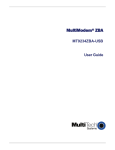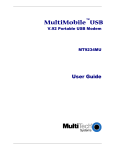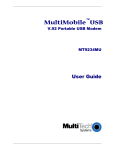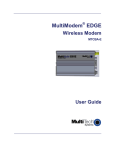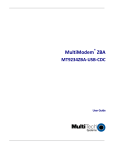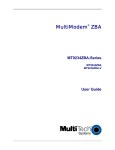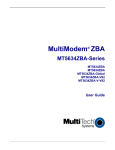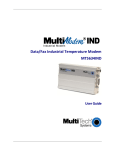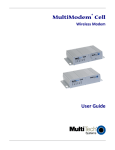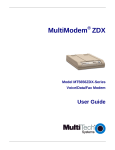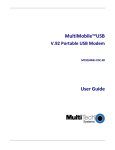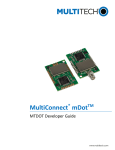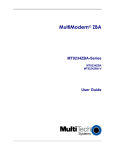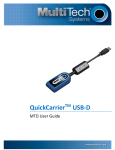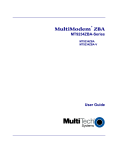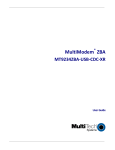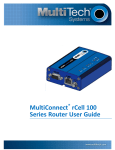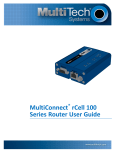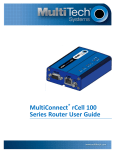Download Multitech Modem MT9234ZBA-USB User's Manual
Transcript
® MultiModem ZBA MT9234ZBA‐USB User Guide MultiModem ZBA User Guide MT934ZBA‐USB S000419E Revision E Copyright All rights reserved. This publication may not be reproduced, in whole or in part, without prior expressed written permission from Multi‐ Tech Systems, Inc. Copyright © 2011 by Multi‐Tech Systems, Inc. Multi‐Tech Systems, Inc. makes no representations or warranties with respect to the contents hereof and specifically disclaims any implied warranties of merchantability or fitness for any particular purpose. Furthermore, Multi‐Tech Systems, Inc. reserves the right to revise this publication and to make changes in the content hereof without obligation of Multi‐Tech Systems, Inc. to notify any person or organization of such revisions or changes. Check Multi‐Tech’s website for current versions of our product documentation. Record of Revisions Revision Date Description C D 12/15/08 05/14/09 09/29/09 E 09/01/2011 Updated Windows Drivers and added Windows Server 2008 support. Added web link for warranty information. Updated FCC statement and EMC, Added information on when the power LED comes on. Added Thailand approval. Removed references to product CD. Trademarks MultiModem, Multi‐Tech, and the Multi‐Tech logo are registered trademarks of Multi‐Tech Systems, Inc. Windows is a registered trademark of Microsoft Corporation in the United States and/or other countries. Other trademarks and trade names mentioned in this publication belong to their respective owners. Patents This device is covered by one or more of the following patents: 6,031,867; 6,012,113; 6,009,082; 5,905,794; 5,864,560; 5,815,567; 5,815,503; 5,812,534; 5,809,068; 5,790,532; 5,764,628; 5,764,627; 5,754,589; D394,250; 5,724,356; 5,673,268; 5,673,257; 5,644,594; 5,628,030; 5,619,508; 5,617,423; 5,600,649; 5,592,586; 5,577,041; 5,574,725; D374,222; 5,559,793; 5,546,448; 5,546,395; 5,535,204; 5,500,859; 5,471,470; 5,463,616; 5,453,986; 5,452,289; 5,450,425; D361,764; D355,658; D355,653; D353,598; D353,144; 5,355,365; 5,309,562; 5,301,274;7082106;7082141;7092406 . Other patents pending. World Headquarters Multi‐Tech Systems, Inc. 2205 Woodale Drive Mounds View, MN 55112 U.S.A Telephone (763) 785‐3500 or (800) 328‐9717 Fax (763) 785‐9874 Contacting Multi‐Tech Support In order to better serve our customers, manage support requests and shorten resolution times, we have created the online web portal allowing you to submit questions regarding Multi‐Tech products directly to our technical support team. Get answers to your most complex questions, ranging from implementation, troubleshooting, product configuration, firmware upgrades and much more. To create an account and submit a Support Case on the Portal, visit support.multitech.com Online Web Portal support.multitech.com The Knowledge Base provides immediate answers to your questions and gives you access to support resolutions for all Multi‐Tech products. Visit our support area on the website for other support services. Knowledge Base and Support Services www.multitech.com/en_US/SUPPORT Technical Support Business Hours: M‐F, 9am to 5pm CST Country Europe, Middle East, Africa: U.S., Canada, all others: By Email [email protected] [email protected] By Phone +(44) 118 959 7774 (800) 972‐2439 or +763‐717‐5863 Warranty To read the warranty statement for your product, please visit: http://www.multitech.com/en_US/COMPANY/Policies/warranty/ 2 Multi‐Tech Systems, Inc. MT9234ZBA‐USB User Guide Contents Chapter 1 – Product Overview and Specifications ............................................................................................... 5 Features Overview ...................................................................................................................................................... 5 Universal Serial Bus (USB) ............................................................................................................................................ 5 Package Contents ........................................................................................................................................................ 6 AT Commands Info ...................................................................................................................................................... 6 Technical Specifications ............................................................................................................................................... 6 Chapter 2 – Installing the Modem ...................................................................................................................... 7 Safety Warning Telecom .............................................................................................................................................. 7 Connecting the Modem to the Computer ..................................................................................................................... 7 Installing the Modem Driver ........................................................................................................................................ 8 Windows Driver Installation Overview ......................................................................................................................... 8 Configuring the Country Where Modem is Used ......................................................................................................... 23 Chapter 3 – Operating the Modem .................................................................................................................... 24 Front Panel................................................................................................................................................................. 24 Connecting to the Internet ......................................................................................................................................... 24 Chapter 4 – Remotely Configuring Modems ...................................................................................................... 26 Remote Configuration Overview ................................................................................................................................. 26 Setting Up Modems for Remote Configuration............................................................................................................ 26 Chapter 5 – Troubleshooting ............................................................................................................................. 28 None of the Indicators Light ....................................................................................................................................... 28 Modem Does Not Respond to Commands ................................................................................................................... 28 Modem Dials But Cannot Connect .............................................................................................................................. 28 Modem Disconnects While Online .............................................................................................................................. 29 Modem Cannot Connect When Answering .................................................................................................................. 30 Modem Doesn’t Work with Caller ID ........................................................................................................................... 30 Fax and Data Software Can’t Run at the Same Time .................................................................................................... 30 Appendix A – Regulatory Compliance ................................................................................................................ 31 FCC Part 68 Telecom ................................................................................................................................................... 31 FCC Part 15 ................................................................................................................................................................. 32 Canadian Limitations Notice ....................................................................................................................................... 32 Industry Canada ......................................................................................................................................................... 33 International Modem Restrictions .............................................................................................................................. 33 EMC, Safety, and R&TTE Directive............................................................................................................................... 33 Thailand Approval ...................................................................................................................................................... 33 Multi‐Tech Systems, Inc. MT9234ZBA‐USB User Guide 3 Contents South African Notice .................................................................................................................................................. 33 Appendix B – Waste Electrical and Electronic Equipment................................................................................... 34 Appendix C – C‐ROHS HT/TS Substance Concentration ...................................................................................... 35 Appendix D – Installing with Linux ..................................................................................................................... 36 Installing the Modem on Computers Running the Linux 2.4 Kernel .............................................................................. 36 Installing the Modem on Computers Using the Linux 2.6 Kernel .................................................................................. 41 Installing the Modem on Computers Using the Linux 2.6.20 Kernel ............................................................................. 45 Appendix E – ASCII Conversion .......................................................................................................................... 47 ASCII Conversion Chart ............................................................................................................................................... 47 Index ................................................................................................................................................................. 48 4 Multi‐Tech Systems, Inc. MT9234ZBA‐USB User Guide Chapter 1 – Product Overview and Specifications Congratulations on your purchase of the MultiModem ZBA‐USB modem. Your MultiModem product data/fax modem supports remote configuration and dial‐up connections. It offers V.34/33.6K fax and Error Correction Mode that reduces fax transmission time by more than half when compared to traditional fax modems. In addition, they are globally approved for use in many countries around the world. This means one model can ship virtually anywhere. This manual helps you install, configure, test, and use your modem. Check Multi‐Tech’s website for current versions of product documentation. Features Overview Your modem includes the following features: ● V.92/56K download speeds and 48K upload speeds when connecting with V.92 servers ● V.44 compression improves data throughput rates ● Class 1.0 and Class 2.1 faxing at speeds to V.34/33.6K bps (Super G3) ● Error Correction Mode (ECM) provides fast and reliable fax transmissions ● Windows Plug‐and‐Play operation ● Linux compatible ● U.S. Caller ID reporting ● Remote configuration for centralized setup and control ● Globally approved models for use in many countries worldwide ● Small footprint and stackable design ● Self‐resetting lightning protection ● Flash memory for easy updates ● USB cable included ● Two‐year warranty Universal Serial Bus (USB) Universal Serial Bus (USB), defined by a consortium of industry leaders, permits connection of multiple low‐speed and medium speed computer peripheral devices such as telephones, modems, printers, keyboards, mice, and scanners; all from a single personal computer port. The specification, based on an open architecture is quickly becoming a standard feature in new desktop and notebook computers. Multi‐Tech Systems, Inc. MT9234ZBA‐USB User Guide 5 Chapter 1 –Product Overview and Specifications Package Contents The MultiModem USB package contains: ● A MultiModem data/fax modem ● A set of four self‐adhesive plastic feet ● One USB cable ● One modular telephone cable AT Commands Info The AT commands are published in a separate Reference Guide. Download this guide from the Multi‐Tech website. Technical Specifications Your MultiModem ZBA‐USB modem has the following specifications: Trade Name Model Number Client‐to‐Server Data Rates Client‐to‐Client Data Rates Fax Data Rates Data Format Modem Compatibility Fax Compatibility Error Correction Data Compression Flow Control Intelligent Features Command Buffer Transmit Level Lightning Protection Frequency Stability Receiver Sensitivity AGC Dynamic Range Connectors Cables Diagnostics Environmental Dimensions Weight Limited Warranty MultiModem® ZBA MT9234ZBA‐USB Up to 50Kbps when accessing a V.92 server (actual speed depends on server capabilities and line conditions); otherwise, the same as client‐to client data lines. 33600, 31200, 28800, 26400, 24000, 21600, 19200, 16800, 14400, 12000, 9600, 7200, 4800, 2400, 1200, 0‐300 bps 33600, 31200, 28800, 26400, 24000, 21600, 19200, 16800, 14400, 12000, 9600, 7200, 4800, 2400, 1200, 0‐300 bps Serial, binary, asynchronous ITU‐T V.92, V.90, V.34 enhanced, V.34, V.34bis, V.32, V.32bis, V.22; Bell 212A and 103; ITU‐T V.21, V.42, V.42bis, V.44 ITU‐T “Super” Group 3, Class 1.0, 2.0, 2.1, T.4, T.30, V.21, V.27ter, V.29, V.34, V.17; TIA/EIA 578 Class 1, 2, TR29.2 ITU‐T V.42 ITU‐T V.44 (4:1 throughput), V.42bis (4:1 throughput), MNP 5 (2:1 throughput) XON/XOFF (software), RTS/CTS (hardware) Plug and play; fully AT command compatible; autodial, redial, repeat dial; pulse or tone dial; dial pauses; auto answer; caller ID; EIA extended automode; adaptive line probing; automatic symbol and carrier frequency during start‐up, retrain, and rate renegotiation; DTMF detection; call status display, auto‐parity and data rate selections; keyboard‐controlled modem options; non‐volatile memory; on‐screen displays for modem option parameters; command lines of up to 40 characters each; remote configuration 40 characters ‐12dBm (Euro/NAM) – varies by country/region setting FCC Part 68 A/B surge ±0.01% ‐43 dBm under worst‐case conditions 43 dB USB connector; two RJ‐11 phone jacks One RJ11 phone cable One USB cable Note: Any cables connected to the computer should be shielded to reduce interference. Power‐on self test, local analog loop, local digital loop, remote digital loop. Temperature range ‐40°– 50°C (‐32°–120°F); humidity range 20–90% (non‐condensing) 10.9 cm wide x 14.5 cm long x 2.5 cm high (4.3” x 5.7” x 1.10”) 227 g (8 oz) 2 year 6 Multi‐Tech Systems, Inc. MT9234ZBA‐USB User Guide Chapter 2 – Installing the Modem This chapter describes how to set up MultiModem ZBA‐USB modems. Safety Warning Telecom ● Use this product only with UL and cUL listed computers. ● To reduce the risk of fire, use only 26 AWG (.41mm) or larger telephone wiring. ● Never install telephone wiring during a lightning storm. ● Never install a telephone jack in wet locations unless the jack is specifically designed for wet locations. ● Never touch uninsulated telephone wires or terminals unless the telephone line has been disconnected at the network interface. ● Use caution when installing or modifying telephone lines. ● Avoid using a telephone during an electrical storm. There is a risk of electrical shock from lightning. ● Do not use a telephone in the vicinity of a gas leak. ● This product must be disconnected from the telephone network interface when servicing. Connecting the Modem to the Computer Placing the modem in a convenient location, connect it to your computer’s USB port, to the telephone line, and, optionally, to your telephone. Connecting the USB Cable Plug one end of the USB cable into the USB connector on the modem, and the other end into a USB port connector on your computer. Multi‐Tech Systems, Inc. MT9234ZBA‐USB User Guide 7 Chapter 2 – Installing the Modem Connecting the Phone Line Plug one end of the phone cable into the modem’s LINE jack and the other end into a phone line wall jack. Note: The LINE jack is not interchangeable with the PHONE jack. Do not plug the phone into the LINE jack or the line cable into the PHONE jack. Note: The Federal Communications Commission (FCC), and Industry Canada impose certain restrictions on equipment connected to public telephone systems. See Appendix A for more information. Connecting a Telephone For voice‐only calls, you can optionally plug a telephone into the modem’s PHONE jack. Installing the Modem Driver Installation Overview Compatibility: This MultiModem is compatible with Windows Operating Systems Vista/XP/2003/2008 and Linux. Windows Drivers: The MultiModem product driver must be installed in your computer’s program directory. You can download the Windows drivers from the Multi‐Tech website. A complete set of drivers for each operating system is organized into Vista and XP with either 32‐bit or 64‐bit processor. Most users select either the 32‐bit Vista or 32‐bit XP drivers (Windows 2003 also use the XP drivers). Server users can select either 32‐bit or 64‐bit depending on their application. For server users to determine whether they have a 32‐bit or 64‐bit operating system, go to Start I All Programs I Accessories I System Tools I Computer and click on the System Properties button. Under System you see System Type: 64‐bit Operating System. Linux Drivers: You can also use the Multi‐Tech website to download Linux Operating System drivers. Refer to the Readme file (also in the Linux directory) for the correct driver file and installation guide for your distribution/version of Linux. Windows Driver Installation Overview This section describes how two install wizards guide you through the software Installation. ● The first wizard installs the TUSB3410 Serial Port. ● The second wizard installs the modem driver. Installing the Modem Driver in Windows Vista Before You Begin 1. Ensure you have downloaded the modem driver from the Multi‐Tech website. 2. Power up your computer. 3. If you have not already done so, connect the modem’s USB cable to a USB port on the computer and connect the phone line between the modem and a telephone wall jack. 4. Windows detects that the new modem is present. 8 Multi‐Tech Systems, Inc. MT9234ZBA‐USB User Guide Chapter 2 – Installing the Modem Installing the Driver for the TUSB3410 Serial Port 1. The Found New Hardware wizard panel appears, indicating that Windows needs to install driver software for your TUSB3410 Serial Port. Click on Locate and install driver software (recommended). Windows guides you through the process of installing driver software for your device. 2. The next pane appears. Select I don’t have the disc. Show me other options. Windows may prompt you to search online, but this is not necessary. Multi‐Tech Systems, Inc. MT9234ZBA‐USB User Guide 9 Chapter 2 – Installing the Modem 3. In the next pane, click Browse my computer for driver software (advanced). 4. At the Browse for driver software on your computer wizard, click Browse. 10 Multi‐Tech Systems, Inc. MT9234ZBA‐USB User Guide 5. Chapter 2 – Installing the Modem In the dialog box that appears, navigate to the area where you stored the drivers you downloaded from the Multi‐Tech website. Click OK. Then click Next. 6. The Would you like to install this device software? pane appears. Click Install. 7. The Installing driver software… pane appears, showing the installation’s progress. Multi‐Tech Systems, Inc. MT9234ZBA‐USB User Guide 11 Chapter 2 – Installing the Modem 8. A wizard pane appears to tell you that the software is now successfully installed. Click Close. Installing the Modem Driver To install the modem driver: 1. The Found New Hardware wizard opens. Select I don’t have the disc. Show me other options. Click Next. 12 Multi‐Tech Systems, Inc. MT9234ZBA‐USB User Guide 2. Chapter 2 – Installing the Modem In the next pane that appears, click Install. 3. The software for this device has been successfully installed pane appears. 4. Click Close. Driver installation is complete. After installation is complete, test the operation of your new MultiModem product by registering it. To do so, go to the following website and follow the on‐line instructions: http://www.multitech.com/register Multi‐Tech Systems, Inc. MT9234ZBA‐USB User Guide 13 Chapter 2 – Installing the Modem Installing the Modem Driver in Windows Server 2008, XP, 2003 This installation assumes a Windows Server 2008, XP, or 2003 operating system. Installing the Serial Port 1. Connect the USB cable between the MultiModem and the PC. 2. The operating system starts a wizard that steps you through the installation. From this pane, select Yes, this time only. Click Next. 3. The Found New Hardware Wizard pane opens. Select Install from a list or specific location (Advanced). Click Next. 14 Multi‐Tech Systems, Inc. MT9234ZBA‐USB User Guide 4. Chapter 2 – Installing the Modem The Please choose your search and installation options appears. Select the Search for the best driver in these locations radio button. Click Browse. 5. Browse to the area where you placed the drivers that you downloaded from the Multi‐Tech website. Click Next. Multi‐Tech Systems, Inc. MT9234ZBA‐USB User Guide 15 Chapter 2 – Installing the Modem 6. The pane, Please wait while the wizard searches for the MT9234ZBA‐USB MultiModem, appears. 7. The pane, Please select the best match for your hardware from the list below, can sometimes appear. If it does select, Select MT9234ZBA‐USB MultiModem. 16 Multi‐Tech Systems, Inc. MT9234ZBA‐USB User Guide 8. Chapter 2 – Installing the Modem A Windows Logo Testing dialog box appears. Click Continue Anyway. 9. A progress pane appears, to indicate that the installation is taking place. Multi‐Tech Systems, Inc. MT9234ZBA‐USB User Guide 17 Chapter 2 – Installing the Modem At the Completing the Found New Hardware Wizard pane, click Finish. Installation of the Serial Port is complete. Installing the Modem Driver To install the modem driver: 1. The Welcome to the Found New Hardware Wizard pane – Can Windows connect to Windows update to search for software appears. Select Yes, this time only. Then click Next. 18 Multi‐Tech Systems, Inc. MT9234ZBA‐USB User Guide 2. Chapter 2 – Installing the Modem In the next wizard pane, click Install from a list or specific location (Advanced). Then click Next. 3. The Please choose your search and installation options pane appears. Select the radio button Search for the best driver in these locations and then select Include this location in the search:. Multi‐Tech Systems, Inc. MT9234ZBA‐USB User Guide 19 Chapter 2 – Installing the Modem 4. Click Browse then navigate to the area where you placed the driver files that you downloaded from the Multi‐ Tech website. Click OK. 5. The Please wait while the wizard searches for the MT9234ZBA‐USB pane appears. 6. In some cases, the following wizard pane can appear. If so, select the desired driver. 20 Multi‐Tech Systems, Inc. MT9234ZBA‐USB User Guide 7. Chapter 2 – Installing the Modem The final Windows Logo Testing pane may appear depending on operating system settings. Click Continue Anyway. 8. The Please wait while the wizard installs the software pane appears. Multi‐Tech Systems, Inc. MT9234ZBA‐USB User Guide 21 Chapter 2 – Installing the Modem 9. The Completing the Found New Hardware Wizard pane appears. Click Finish. With the modem .inf file successfully installed, the entire software installation procedure for the MultiModem product is complete. After installation is complete, test the operation of your new MultiModem product by registering it. To do so, got to the following URL and follow the on‐line instructions: http://www.multitech.com/register 22 Multi‐Tech Systems, Inc. MT9234ZBA‐USB User Guide Chapter 2 – Installing the Modem Configuring the Country Where Modem is Used Different countries have different requirements for how modems must function. Therefore, before you use your modem, configure it to match the defaults of the country in which you are using it. You can use one of two configuration methods: ● Using the Global Wizard to Configure Your Modem ● Using AT Commands to Configure Your Modem Using the Global Wizard to Configure Your Modem The Global Wizard helps you configure the modem for a specific country. It is recommended you run the Global Wizard configuration utility on computers running Windows Server 2008, Vista, XP, and 2003. 1. Download the Global Wizard from the Multi‐Tech website. 2. To install the Global Wizard, double‐click the file you downloaded. 3. In the dialog box that appears, click Run. 4. An Installation Wizard steps you through installation of the utility. 5. After you install the Global Wizard, start it by going to the Windows Start button, select All Programs, then Global Wizard. 6. The Global Wizard dialog box appears. Click Next. 7. The Global Wizard searches for your modem and identifies it. Click Next. 8. Select the country where the modem is used and then click Next. 9. Review your choice of country. If it is correct, click Next to configure the modem. 10. When Global Wizard announces that the parameters have been set, click Finish to exit. Using AT Commands to Configure Your Modem Non‐Windows users can configure the modem using AT commands. You must enter these commands in your communication program’s terminal window. 1. Run your favorite communication program and open the program’s terminal window. 2. To configure the modem for a specific country, type AT%T19,0,nn, where nn is the country code in hexadecimal format, and then press ENTER. The message OK displays. 3. To verify the change, type ATI9, and then press ENTER. The country/region code displays. For example: Country/Region AT command (hexadecimal) Country code (decimal) Euro/NAM AT%T19,0,34 (default) 52 You can find the complete list of country/region codes on the Multi‐Tech website: http://www.multitech.com/en_US/PRODUCTS/Categories/Device_Networking/global_modems/configuration.asp The Global Modem Country Approvals page displays. On this page you can view approvals, configuration strings and responses by country and product. Multi‐Tech Systems, Inc. MT9234ZBA‐USB User Guide 23 Chapter 3 – Operating the Modem Front Panel The MultiModem product has 6 LED indicators on the front panel that indicate status, configuration, and activity. Transmit Data. The TD LED flashes when the modem is transmitting data to another modem. Receive Data. The RD LED flashes when the modem is receiving data from another modem. Carrier Detect. The CD LED lights when the modem detects a valid carrier signal from another modem. It is on when the modem is communicating with the other modem and off when the link is broken. Off‐Hook. The OH LED lights when the modem is off‐hook, which occurs when the modem is dialing, online, or answering a call. The LED flashes when the modem pulse‐dials. Terminal Ready. The TR LED lights when a communications program is using the modem. It means the modem is ready for an outgoing or incoming call. It goes off when the communications program disconnects. When it goes off, a connected modem also disconnects. Power. The PWR led lights when the system is applying power to the modem. Connecting to the Internet Your Multi‐Tech modem is your gateway to the Internet and the World Wide Web. To access the Internet and Web via your modem, you must establish a dial‐up account with an Internet service provider (ISP). To locate an ISP near you, look in a local directory or computer publication. Your ISP should provide you with the following information: ● User name (also called user ID) ● Password ● Access number (the number you call to connect to the server) ● Host name and/or domain name ● Domain Name Server (DNS) server address If, besides the Web, you use the Internet for e‐mail and newsgroups, your ISP should also provide you with the following information: ● E‐mail or POP mail address ● POP server address ● Mail or SMTP address ● News or NNT server address 24 Multi‐Tech Systems, Inc. MT9234ZBA‐USB User Guide Chapter 3 – Operating the Modem Setting up a RemoteNode Client Program Before you can connect to the Internet, you must set up a remote‐node client program on your computer. Windows XP uses HyperTerminal to establish your connection to the ISP’s server, which is the shared computer that manages calls from clients (your computer) to the Internet. Most, if not all, Windows browsers can automatically open this connection. For instructions on how to set up this connection, consult your ISP or your operating system’s online help or printed documentation. Many ISPs include with their service a program that installs and configures this connection automatically for you. Multi‐Tech Systems, Inc. MT9234ZBA‐USB User Guide 25 Chapter 4 – Remotely Configuring Modems Remote configuration is a network management tool that allows you to configure modems anywhere in your network from one location. With password protected remote configuration, you can issue AT commands to a remote MultiModem product for maintenance or troubleshooting as if you were on site. Remote Configuration Overview The following steps are valid regardless of whether the connection is established by the local or the remote Multi‐ Tech modem. 1. Establish a data connection with a remote MultiModem product. 2. Send three remote configuration escape characters followed by AT and the setup password, and press ENTER. Example: %%%ATMTSMODEM. You have four tries to enter the correct password before being disconnected. If the password is correct, the remote modem responds with OK. 3. You can now send AT commands to configure the remote modem. 4. When you have finished configuring the remote modem, save the new configuration by typing AT&W0, and pressing Enter. 5. Type ATO and press Enter to exit remote configuration. You can then break the connection in the normal way. CAUTION: If you hang up while you are in remote configuration mode, the remote modem might lock up. Setting Up Modems for Remote Configuration This section describes how to change the setup password and the remote configuration escape character. Changing the Setup Password Modems are shipped with a default setup password (MTSMODEM). As a precaution, change the default setup password for your Multi‐Tech modems. To change the password: 1. Open a data communications program such as Phone Tools or HyperTerminal. 2. To change the password, type AT#S=xxxxxxxx, where xxxxxxxx stands for the password, and press ENTER. The password can include any keyboard character, and must be one to eight characters long. 3. The modem responds with OK. The new password is saved automatically. You can now either enter more AT commands or exit the data communications program. The next time you remotely configure the modem you must use the new setup password. Note: You can only change the setup password locally; you cannot change the password remotely. Also, passwords are case sensitive. 26 Multi‐Tech Systems, Inc. MT9234ZBA‐USB User Guide Chapter 4 – Remotely Configuring Modems Changing the Remote Escape Character To increase security, you can change a remote modem’s remote configuration escape character. The remote configuration escape character is stored in register S9. The factory default is 37, which is the ASCII code for the percent character (%). For ASCII code characters, refer to Appendix E. Setting S9 to 0 (zero) disables remote configuration entirely—but if you do this remotely, you won’t be able to change it back remotely. 1. Establish a remote configuration link with the remote modem as described in the section “Remote Configuration Overview.” 2. Type ATS9=n where n is the ASCII code for the new remote configuration escape character. 3. Press ENTER. 4. To save the new value type AT&W and press ENTER. 5. To exit remote configuration, type ATO<CR>. Multi‐Tech Systems, Inc. MT9234ZBA‐USB User Guide 27 Chapter 5 – Troubleshooting Your modem was thoroughly tested at the factory before it was shipped. If you are unable to make a successful connection, or if you experience data loss or garbled characters during your connection, it is possible that the modem is defective. However, it is more likely that the source of your problem lies elsewhere. The following symptoms are typical of problems you might encounter: ● None of the LEDs light when the modem is on. ● The modem does not respond to commands. ● The modem dials but is unable to make a connection. ● The modem disconnects while online. ● The modem cannot connect when answering. ● Data is being lost. ● There are garbage characters on the monitor. ● The modem doesn’t work with Caller ID. ● Fax and data software can’t run at the same time. None of the Indicators Light When you plug in the modem, the operating system detects and configures the modem, and the TR LED should come on. If the TR LED does not come on, ensure that the driver has been installed. Modem Does Not Respond to Commands ● Make sure you are issuing the modem commands from data communication software, either manually in terminal mode or automatically by configuring the software. (You cannot send commands to the modem from the DOS prompt.) ● Make sure you are in terminal mode in your data communication program, then type AT and press ENTER. If you get an OK response from your modem, your connections are good and the problem likely is in the connection setup in your communication software. ● Try resetting your modem by unplugging the USB cable from the modem, and then plugging it back in. ● Try rebooting the computer. ● The modem might have a problem beyond the scope of this user guide. If you have another Multi‐Tech modem, try swapping modems. If the problem goes away, the first modem is possibly defective. Call Technical Support for assistance. Modem Dials But Cannot Connect There can be several reasons the modem fails to make a connection. Possibilities include: ● Lack of a physical connection to the telephone line. ● Wrong dial tone ● Busy signal ● Wrong number 28 Multi‐Tech Systems, Inc. MT9234ZBA‐USB User Guide Chapter 5 – Troubleshooting ● No modem at the other end ● A faulty modem, computer, or software at the other end ● Incompatibility between modems You can narrow the list of possibilities by using extended result codes. Extended result codes are enabled by default. If they have been disabled, enter ATV1X4 and press ENTER while in terminal mode, or include V1X4 in the modem’s initialization string. When you dial again, the modem reports the call’s progress. ● If the modem reports NO DIALTONE, check that the modem’s telephone line cable is connected to both the modem’s LINE jack (not the PHONE jack) and the telephone wall jack. If the cable looks secure, try replacing it. If that doesn’t work, the problem might be in your building’s telephone installation. To test the building installation, plug a telephone into your modem’s telephone wall jack and listen for a dial tone. If you hear a dial tone, your modem might be installed behind a company phone system (PBX) with an internal dial tone that sounds different from the normal dial tone. In that case, the modem might not recognize the dial tone and might treat it as an error. Check your PBX manual to see if you can change the internal dial tone; if you can’t, change your modem’s initialization string to replace X4 with X3, which causes the modem to ignore dial tones (note, however, that X3 is not allowed in some countries, such as France and Spain). ● If the modem reports BUSY, the other number might be busy. Try again later, or it might indicate that you failed to add a 9 prefix to the phone number if you must dial 9 for an outside line. ● If you must dial 9 to get an outside line, the easiest way to dial it automatically is to include it in the modem’s dial prefix, for example, ATDT9,. Note the comma, which inserts a pause before the number is dialed. By inserting 9, into the dial prefix, you do not have to include it in each directory entry. ● To change the dial prefix in Windows 98 HyperTerminal, select Call from the Call menu, click Dialing Properties, and type 9 in the local and long distance boxes in How I dial from this location. ● If the modem reports NO ANSWER, the other system has failed to go off‐hook, or you might have dialed a wrong number. Check the number. ● If the modem reports NO CARRIER, the phone was answered at the other end, but no connection was made. You might have dialed a wrong number, and a person answered instead of a computer, or you might have dialed the correct number, but the other computer or software was turned off or faulty. Check the number and try again, or try calling another system to make sure your modem is working. Also, try calling the number on your telephone. If you hear harsh sounds, then another modem is answering the call, and the modems might be having problems negotiating because of modem incompatibilities or line noise. Try connecting at a lower speed. Modem Disconnects While Online ● If you have Call Waiting on the same phone line as your modem, it can interrupt your connection when someone tries to call you. If you have Call Waiting, disable it before each call. In most telephone areas in North America, you can disable Call Waiting by preceding the telephone number with *70 (check with your local telephone company). ● You can automatically disable Call Waiting by including the disabling code in the modem’s dial prefix (e.g., ATDT*70,—note the comma, which inserts a pause before the number is dialed). To change the dial prefix in Windows 98 HyperTerminal, select Call from the Call menu, click Dialing Properties, check This location has Call Waiting, and select the correct code for your phone service. ● If you have extension phones on the same line as your modem, you or someone else can interrupt the connection by picking up another phone. If this is a frequent problem, disconnect the extension phones before using the modem, or install another phone line especially for the modem. ● Check for loose connections between the modem and the computer and the telephone jack. Multi‐Tech Systems, Inc. MT9234ZBA‐USB User Guide 29 Chapter 5 – Troubleshooting ● You might have had a poor connection because of line conditions or the problem might have originated on the other end of the line. Try again. ● If you were online with an online service, it might have hung up on you because of lack of activity on your part or because you exceeded your time limit for the day. Try again. Modem Cannot Connect When Answering ● Autoanswer might be disabled. Turn on autoanswer in your data communications program or send the command ATS0=1 (ATS0=2 if you have Caller ID service) to make sure your modem in terminal mode. Modem Doesn’t Work with Caller ID ● Caller ID information is transmitted between the first and second rings, so if autoanswer is turned off (S0=0) or if the modem is set to answer after only one ring (S0=1), the modem does not receive Caller ID information. Check your initialization string, and if necessary change it to set the modem to answer after the second ring (S0=2). ● Make sure that you have Caller ID service from your telephone company. Fax and Data Software Can’t Run at the Same Time ● 30 Communications devices can be accessed by only one application at a time. In Windows 2003 and higher, you can have data and fax communication applications open at the same time, but they cannot use the same modem at the same time. Multi‐Tech Systems, Inc. MT9234ZBA‐USB User Guide Appendix A – Regulatory Compliance FCC Part 68 Telecom 1. This equipment complies with part 68 of the Federal Communications Commission Rules. On the outside surface of this equipment is a label that contains, among other information, the FCC registration number. This information must be provided to the telephone company. 2. The suitable USOC jack (Universal Service Order Code connecting arrangement) for this equipment is shown below. If applicable, the facility interface codes (FIC) and service order codes (SOC) are shown. 3. An FCC‐compliant telephone cord and modular plug is provided with this equipment. This equipment is designed to be connected to the telephone network or premises wiring using a compatible modular jack that is Part 68 compliant. See installation instructions for details. 4. The ringer equivalence number (REN) is used to determine the number of devices that may be connected to the telephone line. Excessive RENs on the telephone line may result in the device not ringing in response to an incoming call. In most, but not all, areas the sum of the RENs should not exceed 5.0. To be certain of the number of devices that may be connected to the line, as determined by the total RENs, contact the local telephone company. 5. If this equipment causes harm to the telephone network, the telephone company will notify you in advance that temporary discontinuance of service may be required. But if advance notice is not practical, the telephone company will notify you as soon as possible. Also, you will be advised of your right to file a complaint with the FCC if you believe it is necessary. 6. The telephone company may make changes in its facilities, equipment, operations, or procedures that could affect the operation of the equipment. If this happens, the telephone company will provide advance notice in order for you to make necessary modifications in order to maintain uninterrupted service. 7. If trouble is experienced with this equipment (the model of which is indicated below) please contact Multi‐ Tech Systems, Inc. at the address shown below for details of how to have repairs made. If the trouble is causing harm to the telephone network, the telephone company may request you remove the equipment from the network until the problem is resolved. 8. No repairs are to be made by you. Repairs are to be made only by Multi‐Tech Systems or its licensees. Unauthorized repairs void registration and warranty. 9. This equipment should not be used on party lines or coin lines. 10. If so required, this equipment is hearing aid compatible. 11. This product is labeled with the following information: Manufacturer: Trade Name: Model Number: FCC Registration Number: Ren: Modular Jack (USOC): Service Center in USA: MultiTech Systems, Inc. MultiModem® ZBA MT9234ZBA‐USB AU7USA‐24713‐M5‐E 0.3B RJ11 Multi‐Tech Systems, Inc. 2205 Woodale Drive Mounds View, MN 55112 (763) 785‐3500 Fax (763) 785‐9874 Multi‐Tech Systems, Inc. MT9234ZBA‐USB User Guide 31 Appendix A – Regulatory Compliance FCC Part 15 This equipment has been tested and found to comply with the limits for a Class B digital device, pursuant to Part 15 of the FCC Rules. These limits are designed to provide reasonable protection against harmful interference in a residential installation. This equipment generates, uses, and can radiate radio frequency energy, and if not installed and used in accordance with the instructions, may cause harmful interference to radio communications. However, there is no guarantee that interference will not occur in a particular installation. If this equipment does cause harmful interference to radio or television reception, which can be determined by turning the equipment off and on, the user is encouraged to try to correct the interference by one or more of the following measures: ● Reorient or relocate the receiving antenna. ● Increase the separation between the equipment and receiver. ● Plug the equipment into an outlet on a circuit different from that to which the receiver is connected. ● Consult the dealer or an experienced radio/TV technician for help. This device complies with Part 15 of the FCC rules. Operation of this device is subject to the following conditions: 1. This device may not cause harmful interference, and 2. this device must accept any interference that may cause undesired operation. WARNING: Changes or modifications to this unit not expressly approved by the party responsible for compliance could void the user’s authority to operate the equipment. Canadian Limitations Notice Notice: The ringer equivalence number (REN) assigned to each terminal device provides an indication of the maximum number of terminals allowed to be connected to a telephone interface. The termination on an interface may consist of any combination of devices subject only to the requirement that the sum of the ringer equivalence numbers of all the devices does not exceed 5. Notice: The Industry Canada label identifies certificated equipment. This certification means that the equipment meets certain telecommunications network protective, operational and safety requirements. The Industry Canada label does not guarantee the equipment will operate to the user’s satisfaction. Before installing this equipment, users should ensure that it is permissible to be connected to the facilities of the local telecommunications company. The equipment must also be installed using an acceptable method of connection. The customer should be aware that compliance with the above conditions may not prevent degradation of service in some situations. Repairs to certified equipment should be made by an authorized Canadian maintenance facility designated by the supplier. Any repairs or alterations made by the user to this equipment or equipment malfunctions may give the telecommunications company cause to request the user to disconnect the equipment. Users should ensure for their own protection that the electrical ground connections of the power utility, telephone lines and internal metallic water pipe system, if present, are connected together. This precaution may be particularly important in rural areas. Caution: Users should not attempt to make such connections themselves, but should contact the appropriate electric inspection authority, or electrician, as appropriate. 32 Multi‐Tech Systems, Inc. MT9234ZBA‐USB User Guide Appendix A – Regulatory Compliance Industry Canada This Class B digital apparatus meets all requirements of the Canadian Interference‐Causing Equipment Regulations. Cet appareil numérique de la classe B respecte toutes les exigences du ‐Reglement Canadien sur le ‐matériel brouilleur. International Modem Restrictions Some dialing and answering defaults and restrictions may vary for international modems. Changing settings may cause a modem to become non‐compliant with ‐national telecom requirements in specific countries. Also note that some software packages may have features or lack restrictions that may cause the modem to become non‐ compliant. EMC, Safety, and R&TTE Directive The CE mark is affixed to this product to confirm compliance with the following European Community Directives: ● Council Directive 2004/108/EC of 15 December 2004 on the approximation of the laws of Member States relating to electromagnetic compatibility; and ● Council Directive 2006/95/EC of 12 December 2006 on the harmonization of the laws of Member States relating to electrical equipment designed for use within certain voltage limits; and ● Council Directive 1999/5/EC of 9 March 1999 on radio equipment and telecommunications terminal equipment and the mutual recognition of their conformity. Thailand Approval Translation in Thai “This telecom device and equipment is conform to technical standard no….” or “This telecom device and equipment is conform to requirement to NTC” “เครื่องโทรคมนาคมและอุปกรณนี้ มีความสอดคลองตามมาตรฐานทางเทคนิค เลขที่.........” or “เครื่องโทรคมนาคมและอุปกรณนี้ มีความสอดคลองตามขอกําหนดของ กทช.” South African Notice This modem must be used in conjunction with an approved surge protection device. Multi‐Tech Systems, Inc. MT9234ZBA‐USB User Guide 33 Appendix B – Waste Electrical and Electronic Equipment July, 2005 The WEEE directive places an obligation on EU‐based manufacturers, distributors, retailers and importers to take‐ back electronics products at the end of their useful life. A sister Directive, ROHS (Restriction of Hazardous Substances) complements the WEEE Directive by banning the presence of specific hazardous substances in the products at the design phase. The WEEE Directive covers all Multi‐Tech products imported into the EU as of August 13, 2005. EU‐based manufacturers, distributors, retailers and importers are obliged to finance the costs of recovery from municipal collection points, reuse, and recycling of specified percentages per the WEEE requirements. Instructions for Disposal of WEEE by Users in the European Union The symbol shown below is on the product or on its packaging, which indicates that this product must not be disposed of with other waste. Instead, it is the user’s responsibility to dispose of their waste equipment by handing it over to a designated collection point for the recycling of waste electrical and electronic equipment. The separate collection and recycling of your waste equipment at the time of disposal will help to conserve natural resources and ensure that it is recycled in a manner that protects human health and the environment. For more information about where you can drop off your waste equipment for recycling, please contact your local city office, your household waste disposal service or the seller from whom you purchased the product. 34 Multi‐Tech Systems, Inc. MT9234ZBA‐USB User Guide Appendix C – C-ROHS HT/TS Substance Concentration 依照中国标准的有毒有害物质信息 根据中华人民共和国信息产业部 (MII) 制定的电子信息产品 (EIP) 标准-中华人民共和国《电子信息产品污染控制管理办法》(第 39 号),也称作中国 RoHS,下表列出了 Multi‐Tech Systems Inc. 产品中可能含有的有毒物质 (TS) 或有害物质 (HS) 的名称及含量水平方面的信息。 有害/有毒物质/元素 成分名称 铅 (PB) 汞 (Hg) 镉 (CD) 六价铬 (CR6+) 多溴联苯 (PBB) 多溴二苯醚 (PBDE) 印刷电路板 O O O O O O 电阻器 X O O O O O 电容器 X O O O O O 铁氧体磁环 O O O O O O O O O O O O O O O O O O O O O O O O 振荡器和晶振 X O O O O O 调节器 O O O O O O 电压传感器 O O O O O O 变压器 O O O O O O 扬声器 O O O O O O 连接器 LED O O O O O O O O O O O O 螺丝、螺母以及 其它五金件 X O O O O O 交流‐直流电源 O O O O O O 软件/文档 CD O O O O O O 手册和纸页 O O O O O O 底盘 O O O O O O 继电器/光学部 件 IC 二极管/晶体管 X 表示所有使用类似材料的设备中有害/有毒物质的含量水平高于 SJ/Txxx‐2006 限量要求。 O 表示不含该物质或者该物质的含量水平在上述限量要求之内。 Multi‐Tech Systems, Inc. MT9234ZBA‐USB User Guide 35 Appendix D – Installing with Linux Your Multi‐Tech modem supports Linux 2.4 kernel versions (2.4.28 and above), 2.6 kernel versions 2.6.8 through 2.6.10, and, with a special patch, Linux kernel versions 2.6.11 through 2.6.20.4. There are three separate installation procedures for these ranges of kernel versions. When installation is complete, you must use AT commands to configure the modem for the country in which it is operating. Installing the Modem on Computers Running the Linux 2.4 Kernel Installation Overview This procedure applies to Linux 2.4 kernel versions 2.4.28 and above. These tgz and source RPM packages (ti_usb‐1.2.tgz and ti_usb‐1.2‐1.src.rpm) contain a device driver for your Multi‐Tech modem’s TI USB 3410 processor in the Linux 2.4 kernels. This package is designed for these hardware platforms: a standard PC with i486, Pentium, or compatible CPUs (32 bit x86). This package has been tested on these Linux distributions: ● Red Hat 8.0 ● Red Hat 9.0 ● SUSE Linux Standard Server 8.0 Most likely this package works on many other Linux distributions based on the 2.4 kernels, but this has not yet been tested. Note that different distributions can make custom changes to the Linux kernel, and there is a small chance that these changes might be incompatible with this package. This package does not work in the Linux 2.6 kernels. Separate packages of the TI USB 3410/5052 driver are available for the Linux 2.6 kernels. These packages are available from http://www.brimson.com/downloads The tgz package is named ti_usb‐X.Y.tgz, and the source RPM package is named ti_usb‐X.Y‐Z.src.rpm, where X.Y‐Z is the version number. See www.brimson.com/downloads/README for a description of the packages available. If you have questions or problems with this package please contact Texas Instruments technical support or Brimson technical support. 36 Multi‐Tech Systems, Inc. MT9234ZBA‐USB User Guide Appendix D – Installing with Linux Installing Kernel Sources To build the TI USB driver you must have the matching kernel sources for your kernel. To verify that you have matching kernel sources: 1. Run "uname ‐r" to get the version of the running kernel. 2. Check for the directory /usr/src/linux‐<version>, /lib/modules/<version>/source, /lib/modules/<version>/build, or /usr/src/linux‐<stripped_version>, where stripped_version has the extra version information removed. 3. In these directories look for the files include/linux/autoconf.h and .config. If you do not find the correct kernel source directory, you must find and install the kernel sources from your distribution CDs or other media. Preparing Kernel Sources This step may or may not be necessary, depending on how your Linux distribution installs the kernel sources. Log in as root and do the following: Command Explanation 1. cd /usr/src/linux‐<version> Change to the source directory. 2. make mrproper Clean up any old files. 3. Use either of these commands: Make a configuration file to match your running kernel. make oldconfig for Red Hat ‐OR‐ make cloneconfig for SUSE For other distributions these same commands might work, or you might need to find a config file in /boot or in a configs directory, copy it to .config, and run "make oldconfig". 4. make dep Create the dependency and version files. If you have built your own kernel, the kernel sources are already be installed and prepared. If you are using a kernel that came with a Linux distribution, it can sometimes be difficult to get the kernel sources correctly installed and prepared, since each Linux distribution handles kernel sources slightly differently. For example, if you get errors about the wrong kernel version, you may have installed the wrong kernel sources, or you may need to edit the kernel version in the top level Makefile of the kernel sources. If you get compilation errors, perhaps you forgot to run "make oldconfig" and "make dep". If you have difficulties, look carefully at the error messages when installing the TGZ or RPM packages‐‐those messages should give you an indication of just what the error is. Multi‐Tech Systems, Inc. MT9234ZBA‐USB User Guide 37 Appendix D – Installing with Linux Building and Installing the TI USB Driver from the Source RPM Package Follow this step if your distribution supports RPM packages; otherwise, follow the next step on installing from a TGZ package. You need the TI USB source RPM package for this step. The Introduction section above describes where to find the latest TI USB source RPM. Log in as root and do the following: Command Explanation 1. This command builds the driver package for your kernel. rpmbuild ‐‐rebuild ti_usb‐X.Y‐Z.src.rpm ‐‐ OR ‐‐ rpm ‐‐rebuild ti_usb‐X.Y‐Z.src.rpm For Red Hat. For SUSE. 2. cd /usr/src/redhat/RPMS/i386 ‐‐ OR ‐‐ cd /usr/src/packages/RPMS/i386 For Red Hat. For SUSE. Or use the appropriate path for your Linux distribution. 3. rpm ‐Uvh ti_usb‐X.Y‐Z.i386.rpm This command installs the driver package. If there are problems in this process, you may need to go back to install and prepare the kernel sources as described above. You may need to remove the RPM package with "rpm ‐e ti_usb‐X.Y‐Z" or remove RPM temporary files. Red Hat stores RPM temporary files in /var/tmp and /usr/src/redhat/BUILD; other distributions may store them in other places. 38 Multi‐Tech Systems, Inc. MT9234ZBA‐USB User Guide Appendix D – Installing with Linux Building and Installing the TI USB Driver from the TGZ Package You need the TI USB tgz package for this step. The Introduction section above describes where to find the latest TI USB tgz package. Log in as root and do the following: Command Explanation 1. tar xvzf ti_usb‐X.Y.tgz Un‐package the files. 2. cd ti_usb‐X.Y 3. ./configure Configure the package for your distribution and kernel. 4. make Build the driver. 5. make install Install the ti_usb driver. If there are problems in this process, you may need to go back to install and prepare the kernel sources as described above. Loading the TI USB Driver The ti_usb driver should be automatically loaded when you plug in the TI USB 3410 device, provided your device uses the default vendor and product ids. If it does not, see the section entitled "VENDOR and PRODUCT IDS" in the Release Notes file for Linux 2.4 kernel installations. The first TI USB 3410 device plugged in appears as /dev/ttyTIUSB0, the next as /dev/ttyTIUSB1, and so on. Note that these device names are different from the device names used by the Linux usbserial driver. For more information, see the following section “Device Files”. If TI USB devices had been in use before installing the new TI USB driver, old versions of the drivers are still be loaded. You must unload these old versions before the newly installed driver can be used. To unload old drivers and load new driver: 1. Reboot Or 2. Close all open TI USB serial ports. 3. Disconnect the TI USB serial devices. 4. Unload the old TI USB serial driver with the command rmmod ti_usb 5. Reconnect the TI USB serial devices and the new driver is loaded. Multi‐Tech Systems, Inc. MT9234ZBA‐USB User Guide 39 Appendix D – Installing with Linux Device Files Because the TI USB driver does not use usbserial (to avoid known problems with usbserial) it uses its own device file names, /dev/ttyTIUSB0, /dev/ttyTIUSB1, and so on. The device files are created automatically when the ti_usb driver is loaded. This is done by the module post‐ install command in /etc/modules.conf, which runs the script /etc/ti_usb/make_devices. You can change the device names that ti_usb uses. First you should remove the old device files by running /etc/ti_usb/make_devices remove Then edit /etc/ti_usb/make_devices. At the top of this file you find the parameters DEVICE_NAME which determines the basename of the TI USB device files, DEVICE_COUNT which determines the number of device files created, DEVICE_GROUP which determines the group owner of the device files, and DEVICE_PERMISSIONS which determines the device file permissions. For example, to create 8 TI USB device files named /dev/ttyusb0 through /dev/ttyusb7, owned by the uucp group, and having permissions 0660, change the parameters like this DEVICE_NAME=/dev/ttyusb DEVICE_COUNT=8 DEVICE_GROUP=uucp DEVICE_PERMISSIONS=0660 After editing make_devices, run the script to create the new device files, like this /etc/ti_usb/make_devices If you use devfs, the ti_usb devices are /dev/usb/ti/0, /dev/usb/ti/1, and so on in the order they are plugged in. The ti_usb driver has not been tested with devfs. Uninstalling the TI USB Driver (for 2.4 kernel versions) If you installed the TI USB RPM package, you can uninstall it by logging in as root and running the command rpm ‐e ti_usb‐X.Y‐Z If you installed the TI USB TGZ package, you can uninstall it by logging in as root and running the following commands: Command Explanation cd ti_usb‐X.Y Give a full or relative path to the unpacked source file directory. make uninstall 40 Multi‐Tech Systems, Inc. MT9234ZBA‐USB User Guide Appendix D – Installing with Linux Installing the Modem on Computers Using the Linux 2.6 Kernel Installation Overview This procedure applies to Linux 2.6 kernel versions 2.6.8 through 2.6.10. These tgz and source RPM packages (ti_usb_2.6‐1.2.tgz and ti_usb_2.6‐1.2‐1.src.rpm) contain a device driver for the MULTIMODEM PRODUCT ’s TI USB 3410 processor in the Linux 2.6 kernels. These packages have been tested on the Fedora Core 2 Linux distribution. Most likely these packages work on many other Linux distributions based on the 2.6 kernels, but this has not yet been tested. Note that different distributions can make custom changes to the Linux kernel, and there is a small chance that these changes might be incompatible with this package. The TI USB 3410/5052 driver has been tested in the kernel.org kernels 2.6.5 through a pre‐release version of 2.6.10, and in the Fedora Core 2 kernels 2.6.5‐1.358 and 2.6.9‐1.6. There are limitations in kernels before 2.6.8; see the section on Known Limitations in the Release Notes file for kernel 2.6. These packages do not work in the Linux 2.4 kernels (however, installation in the 2.4 kernels is covered earlier in this chapter). These packages are available from http://www.brimson.com/downloads The tgz package is named ti_usb_2.6‐X.Y.tgz, and the source RPM package is named ti_usb_2.6‐X.Y‐Z.src.rpm, where X.Y‐Z is the version number. See www.brimson.com/downloads/README for a description of the packages available. If you have questions or problems with this package, please contact Texas Instruments technical support or Brimson technical support. Installing the Kernel Sources To build the TI USB driver you must have the matching kernel sources for your kernel. In particular, you must have the file usb‐serial.h for your kernel sources. Sometimes Linux distributions include the kernel headers but not the complete kernel sources, and usb‐serial.h is missing. However, the complete kernel sources should still be available as a separate add‐on package. To verify that you have matching kernel sources, run "uname ‐r" to get the version of the running kernel. Then check for the directory /usr/src/linux‐<version>, /lib/modules/<version>/source, /lib/modules/<version>/build, or /usr/src/linux‐<stripped_version>, where stripped_version has the extra version information removed. In these directories look for the files include/linux/autoconf.h, .config, and drivers/usb/serial/usb‐serial.h. If you do not find the correct kernel source directory, you must find and install the kernel sources from your distribution CDs or other media. Multi‐Tech Systems, Inc. MT9234ZBA‐USB User Guide 41 Appendix D – Installing with Linux Preparing the Kernel Sources This step may or may not be necessary, depending on how your Linux distribution installs the kernel sources. Log in as root and do the following: Command Explanation 1. cd /usr/src/linux‐<version> Change to the source directory. 2. make mrproper Clean up any old files. 3. Use either of these commands: Make a configuration file to match your running kernel. make oldconfig for Red Hat ‐OR‐ make cloneconfig for SUSE For other distributions these same commands might work, or you might need to find a config file in /boot or in a configs directory, copy it to .config, and run "make oldconfig". 4. make prepare To prepare the kernel sources for your machine. If you built your own kernel, the kernel sources are already be installed and prepared. If you are using a kernel that came with a Linux distribution, it can sometimes be difficult to get the kernel sources correctly installed and prepared, since each Linux distribution handles kernel sources slightly differently. For example, if you get errors about the wrong kernel version, you may have installed the wrong kernel sources, or you may need to edit the kernel version in the top level Makefile of the kernel sources. If you get errors about a missing usb‐serial.h, you may only have the kernel headers installed. If you have trouble getting the full kernel sources installed and prepared, you can copy the correct version of usb‐ serial.h to drivers/usb/serial in the kernel headers directory and then the other kernel sources are not needed. If you have difficulties, look carefully at the error messages when installing the TGZ or RPM packages. Those messages provide an indication of what the error is. 42 Multi‐Tech Systems, Inc. MT9234ZBA‐USB User Guide Appendix D – Installing with Linux Building and Installing the TI USB Driver from the Source RPM Package Follow this step if your distribution supports RPM packages; otherwise, follow the next step on installing from a TGZ package. You need the TI USB 3410/5052 source RPM package for this step. The Introduction section describes where to find the latest TI USB 3410/5052 source RPM. Log in as root and do the following: Command Explanation 1. This command builds the driver package for your kernel. rpmbuild ‐‐rebuild ti_usb_2.6‐X.Y‐Z.src.rpm ‐‐ OR ‐‐ rpm ‐‐rebuild ti_usb_2.6‐X.Y‐Z.src.rpm For Red Hat. For SUSE. 2. cd /usr/src/redhat/RPMS/i386 ‐‐ OR ‐‐ cd /usr/src/packages/RPMS/i386 For Red Hat. For SUSE. Or use the appropriate path for your Linux distribution. 3. rpm ‐Uvh ti_usb_2.6‐X.Y‐Z.i386.rpm This command installs the driver package. If there are problems in this process, you may need to go back to install and prepare the kernel sources as described above. You may need to remove the RPM package with "rpm ‐e ti_usb_2.6‐X.Y‐Z" or remove RPM temporary files. Red Hat stores RPM temporary files in /var/tmp and /usr/src/redhat/BUILD; other distributions may store them in other places. Multi‐Tech Systems, Inc. MT9234ZBA‐USB User Guide 43 Appendix D – Installing with Linux Building and Installing the TI USB Driver from the TGZ Package Follow this step if your distribution does not support RPM packages; otherwise, follow the previous step on installing from an RPM package. You need the TI USB 3410/5052 tgz package for this step. The Introduction section above describes where to find the latest TI USB 3410/5052 tgz package. Log in as root and do the following: Command Explanation 1. tar xvzf ti_usb_2.6‐X.Y.tgz Un‐package the files. 2. cd ti_usb_2.6‐X.Y 3. ./configure Configure the package for your distribution and kernel. 4. make install Build and install the ti_usb_3410_5052 driver. If there are problems, you may need to go back to install and prepare the kernel sources as described above. Loading the TI USB 3410/5052 Driver The ti_usb_3410_5052 driver should be automatically loaded when you plug in the TI USB 3410/5052 devices, provided your device uses the default vendor and product ids. If it does not, see the section of the Release Notes file "VENDOR and PRODUCT IDS". The first TI USB 3410/5052 device plugged in appears as /dev/ttyUSB0, then next as /dev/ttyUSB1, and so on. These device names are shared with other USB serial devices. If TI USB devices had been in use before installing the new TI USB driver, old versions of the drivers can still be loaded. You must unload these old versions before the newly installed driver is used. To unload old drivers and load new driver: 1. Reboot or 2. Close all open TI USB serial ports. 3. Disconnect the TI USB serial devices. 4. Unload the old TI USB serial driver with the command rmmod ti_usb_3410_5052 5. Reconnect the TI USB serial devices and the new driver is loaded. Uninstalling the TI USB Driver (for 2.6 kernel versions) If you installed the TI USB RPM package, you can uninstall it by logging in as root and running the command rpm ‐e ti_usb_2.6‐X.Y‐Z If you installed the TI USB TGZ package, you can uninstall it by logging in as root and using these commands: Command Explanation cd ti_usb_2.6‐X.Y Provide a full or relative path to the unpacked source file directory. make uninstall 44 Multi‐Tech Systems, Inc. MT9234ZBA‐USB User Guide Appendix D – Installing with Linux Installing the Modem on Computers Using the Linux 2.6.20 Kernel Installation Overview This procedure applies to Linux 2.6 kernel versions 2.6.11 through 2.6.20 and higher. This tgz package contains a patch for the Linux kernel version 2.6.20 and later to add support for Multi‐Tech modems. The patch was generated from the 2.6.20.4 kernel source. Additional support files like hotplug scripts, udev rules and firmware images are also included. The TI USB 3410/5052 driver should be included in the official Linux kernel in version 2.6.20 or later. The official Linux kernel does not yet have support for the Multi‐Tech modems, however; to add that support you need this package. This package has been tested on these Linux distributions: (a) Fedora Core 6, and (b) CentOS 5. Most likely this package works on many other Linux distributions based on the 2.6 kernels, but this has not yet been tested. Note that different distributions can make custom changes to the Linux kernel, and there is a small chance that these changes might be incompatible with this package. These packages are available from http://www.brimson.com/downloads If you have questions or problems with this package, please contact Texas Instruments technical support or Brimson technical support. Patching and Rebuilding the Kernel Apply the patch ti_usb_multitech_2.6.20.4.patch. This patch should apply to 2.6.20.4 and later kernels. Then rebuild and reinstall your kernel and/or kernel modules. Be sure the TI USB driver is configured on. Detailed instructions on patching and building a kernel can be found elsewhere. Installing the Hotplug Scripts The ti_usb_3410_5052 driver needs a hotplug script to work correctly. This hotplug script is used to change the device configuration. Copy ti_usb_3410_5052 to /etc/hotplug/usb/ti_usb_3410_5052. Be sure the script is owned by root:root and has permissions r‐xr‐xr‐x. If the device configuration is not being set properly, you might need a slightly different hotplug script, depending on your Linux distribution. If this does not work, remove /etc/hotplug/usb/ti_usb_3410_5052 and instead copy /etc/ti_usb/ti_usb_3410_5052.hotplug into /etc/hotplug.d/usb. Some distribution have deprecated hotplug scripts. If this is the case, you most likely need a udev rule to perform this function. Installing udev Rules The ti_usb_3410_5052 driver needs a udev rule to work correctly. This udev rule is used to change the device configuration. Copy 25_ti_usb_3410_5052.rule to /etc/udev/rules.d. Be sure the rule is owned by root:root and has permissions r‐xr‐xr‐x. If the device configuration is not being set properly, you might need a slightly different udev rule, depending on your Linux distribution. Note: This is only needed if firmware is not built into the driver. Multi‐Tech Systems, Inc. MT9234ZBA‐USB User Guide 45 Appendix D – Installing with Linux Installing the Firmware Images Copy ti_mts_fw_cdma, ti_mts_fw_edge, ti_mts_fw_gsm, ti_mts_fw_MULTIMODEM PRODUCT and ti_mts_fw_mt9234zbausb to /usr/lib/hotplug/firmware/ or /lib/firmware depending on your distribution. Be sure the files are owned by root:root and have permissions r‐‐r‐‐r‐‐. Loading the TI USB 3410/5052 Driver The ti_usb_3410_5052 driver should be automatically loaded when you plug in the TI USB 3410/5052 devices, provided your device uses the default vendor and product ids. If it does not, see the section of the Release Notes file "VENDOR and PRODUCT IDS". The first TI USB 3410/5052 device plugged in appears as /dev/ttyUSB0, then next as /dev/ttyUSB1, and so on. These device names are shared with other USB serial devices. If TI USB devices had been in use before installing the new TI USB driver, old versions of the drivers can still be loaded. You must unload these old versions before the newly installed driver is used. The simplest way to unload the old drivers and load the new is to reboot. Alternatively, you can close all open TI USB serial ports, disconnect the TI USB serial devices, and then unload the old TI USB serial driver with the command rmmod ti_usb_3410_5052 Then reconnect the TI USB serial devices and the new driver is loaded. Uninstalling the TI USB Driver (for 2.6 kernel versions) If you installed the TI USB RPM package, you can uninstall it by logging in as root and running the command rpm ‐e ti_usb_2.6‐X.Y‐Z If you installed the TI USB TGZ package, you can uninstall it by logging in as root and running the following commands: Command Explanation cd ti_usb_2.6‐X.Y Provide a full or relative path to the unpacked source file directory. make uninstall 46 Multi‐Tech Systems, Inc. MT9234ZBA‐USB User Guide Appendix E – ASCII Conversion ASCII Conversion Chart CTRL CODE HEX @ A B C D E F G H I J K L M N O P Q R S T U V W X Y Z [ \ ] ^ _ NUL SOH STX ETX EOT ENQ ACK BEL BS HT LF VT FF CR SO SI DLE DC1 DC2 DC3 DC4 NAK SYN ETB CAN EM SUB ESC FS GS RS US 00 01 02 03 04 05 06 07 08 09 0A 0B 0C 0D 0E 0F 10 11 12 13 14 15 16 17 18 19 1A 1B 1C 1D 1E 1F DEC 0 1 2 3 4 5 6 7 8 9 10 11 12 13 14 15 16 17 18 19 20 21 22 23 24 25 26 27 28 29 30 31 CODE SP ! " # $ % & ' ( ) * + , . / 0 1 2 3 4 5 6 7 8 9 : ; < = > ? HEX 20 21 22 23 24 25 26 27 28 29 2A 2B 2C 2D 2E 2F 30 31 32 33 34 35 36 37 38 39 3A 3B 3C 3D 3E 3F DEC CODE HEX DEC 32 33 34 35 36 37 38 39 40 41 42 43 44 45 46 47 48 49 50 51 52 53 54 55 56 57 58 59 60 61 62 63 @ A B C D E F G H I J K L M N O P Q R S T U V W X Y Z [ \ ] ^ _ 40 41 42 43 44 45 46 47 48 49 4A 4B 4C 4D 4E 4F 50 51 52 53 54 55 56 57 58 59 5A 5B 5C 5D 5E 5F 64 65 66 67 68 69 70 71 72 73 74 75 76 77 78 79 80 81 82 83 84 85 86 87 88 89 90 91 92 93 94 95 CODE ` a b c d e f g h i j k l m n o p q r s t u v w x y z { | } ~ DEL HEX DEC 60 61 62 63 64 65 66 67 68 69 6A 6B 6C 6D 6E 6F 70 71 72 73 74 75 76 77 78 79 7A 7B 7C 7D 7E 7F 96 97 98 99 100 101 102 103 104 105 106 107 108 109 110 111 112 113 114 115 116 117 118 119 120 121 122 123 124 125 126 127 NUL Null, or all zeros VT Vertical Tab SYN Sync. SOH Start of Header FF ETB End Transmission Block STX Start of Text CR Carriage Return CAN Cancel ETX End of Text SO Shift Out EM End of Medium EOT End of Transmission SI SUB Substitute ENQ Enquiry DLE Data Link Escape ESC Escape ACK Acknowledge DC1 Device Control 1 FS File Separator BEL Bell or Alarm DC2 Device Control 2 GS Group Separator BS Backspace DC3 Device Control 3 RS Record Separator HT Horizontal Tab DC4 Device Control 4 US Unit Separator LF NAK Negative Acknowledge DEL Delete Line Feed Form Feed Shift In Multi‐Tech Systems, Inc. MT9234ZBA‐USB User Guide 47 Index A P AT Commands ................................................................... 6 autoanswer ....................................................................... 31 phone connection ............................................................... 9 R C remote configuration........................................................ 27 escape character ........................................................... 28 remote node operation ..................................................... 26 result codes ...................................................................... 30 Call Waiting ..................................................................... 30 Caller ID........................................................................... 31 Canadian regulations ........................................................ 33 connecting the modem ....................................................... 8 S D Safety Warning Telecom ................................................... 8 solving problems.............................................................. 29 specifications, technical ..................................................... 6 S-registers S9 ................................................................................. 28 DOC regulations............................................................... 33 F FCC regulations ............................................................... 32 front panel ........................................................................ 25 T G technical specifications ...................................................... 6 telephone line................................................................... 29 telephone, connecting a ..................................................... 9 testing the modem............................................................ 30 troubleshooting ................................................................ 29 Global Wizard .................................................................. 24 I indicators .......................................................................... 25 initialization strings .......................................................... 30 Install the Modem Driver ................................................... 9 V Vista Operating System and Driver Installation ................ 9 L W LED indicators ................................................................. 25 LED Indicators ................................................................. 29 line connection ................................................................... 8 Linux 2.4 installation 2.4.28 and above ........................................................... 37 Linux 2.6 installation 2.6.11 through 2.6.20 and higher .................................. 46 2.6.8 through 2.6.10 ...................................................... 42 Linux Drivers.................................................................... 9 warranty ........................................................................... 32 Waste Electrical and Electronic Equipment WEEE Statement...................................................................... 35 WEEE directive ............................................................... 35 Windows Server 2008, XP, or 2003 operating system. ... 15 Windows XP & 2003 and the Modem Driver ................. 23 48 Multi‐Tech Systems, Inc. MT9234ZBA‐USB User Guide
















































